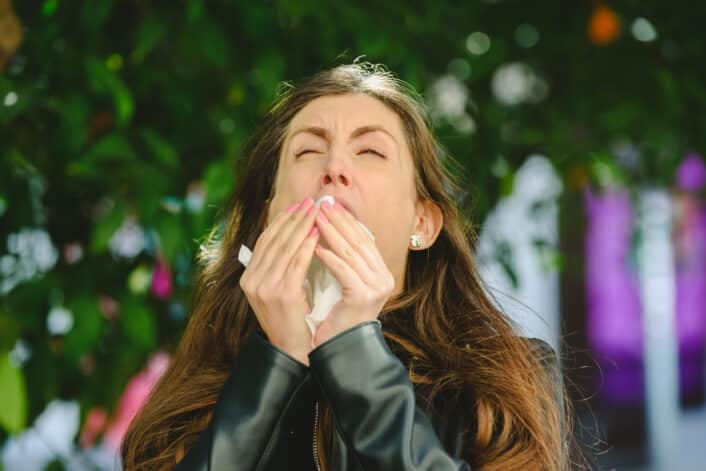

Disclaimer: This article is for informational purposes only and is not intended to diagnose any conditions. LifeDNA does not provide diagnostic services for any conditions mentioned in this or any other article.
Ever step outside on a sunny day and feel an urge to sneeze? If so, you might be among the 18-35% of people who experience the photic sneeze reflex (PSR), also known as the “sun sneeze.” This reflex occurs when exposure to bright light, particularly sunlight, triggers sneezing.
The photic sneeze reflex is a phenomenon where sudden exposure to bright light, particularly sunlight, triggers sneezing. This reflex isn’t exclusive to sunlight; any abrupt transition to bright light, such as from a camera flash or stepping from a dim room into a well-lit space, may also cause it.
The medical term for this reflex is “autosomal dominant compelling helio-ophthalmic outburst” ACHOO syndrome, which simply means uncontrollable sneezing in response to sunlight. The reflex typically begins with a tickling sensation in the nose, followed by one or more sneezes when exposed to light.
Interestingly, the phenomenon wasn’t formally studied until the 1950s, when French researcher Jean Sedan observed that some of his patients sneezed in response to the light from his ophthalmoscope, a tool used to examine the eyes. He realized that various types of bright light could trigger sneezing.
The photic sneeze reflex is a curious phenomenon where sneezing is triggered by sudden exposure to bright light. This reflex doesn’t occur just because of bright light alone, but rather due to a rapid change in light intensity. For example, stepping into direct sunlight after being in a dark room or driving through a tunnel on a sunny day and sneezing upon exiting are common triggers.
The exact cause of this reflex isn’t fully understood, but scientists have a few theories. One leading idea is that it involves a mix-up in the brain’s signaling system. When bright light hits the eyes, it stimulates the optic nerve, which helps us see. In people with the photic sneeze reflex, this stimulation might accidentally trigger the trigeminal nerve, which is responsible for sneezing. This overlap in nerve signals could be why a sudden burst of light may cause sneezing.
While the precise reason for this reflex and its purpose are still unclear, this explanation of nerve misfiring is the most commonly accepted one.
Research indicates that this reflex is inherited and follows an autosomal dominant pattern. Researchers have identified several genetic markers that can help predict if you’re likely to sneeze in response to sunlight. Among the genes associated with this trait are ZEB2, found on chromosome 2, and NRF2 found on chromosome 15, both of which are associated with nervous system function and sensitivity. Additionally this means if one parent has photic sneeze reflex (PSR), there’s a 50% chance their child will inherit it too. However, the exact genetic mechanisms underlying PSR are still being explored.
Scientists are still studying the genetic factors behind PSR. Variants known as single nucleotide polymorphisms (SNPs) in this gene may lead to a more sensitive nervous system, making someone more prone to PSR. SNPs in other genes play a role too, for example, having a C instead of a T-allele in the genetic marker rs10427522 which is in between genes SUMO3 and PTTG1IP is linked to a higher likelihood of developing PSR.
Understanding the genetic causes of PSR is crucial as it could provide insights into human genetics and related conditions like photosensitive epilepsy. Studies of these genetic markers help in identifying the biological mechanisms behind the reflex and how they might be linked to other genetic disorders.
In addition to the broader implications for human genetics, research has also highlighted demographic patterns and other characteristics associated with PSR. According to a 1995 study on photic sneezing, the condition is more common in people who are white, and especially women and people assigned female at birth . Having a deviated septum may also have something to do with it.
To delve deeper into the genetics of PSR, researchers conducted a study with 3,417 Chinese participants, where 25.6% reported experiencing PSR. They discovered two important genetic markers: one previously known (rs10427255 on chromosome 2) and a new one (rs1032507 on chromosome 3, located in a non-protein coding RNA 971). The genetic variants either increased or decreased the chances of having PSR and can improve the ability to predict who might have PSR.
Further research, focusing on the Japanese population. Researchers analyzed saliva samples from 11,409 participants who completed a web survey. After filtering the genetic data, 210,086 SNPs were studied. The prevalence of PSR in the group was found to be 3.2%. The study confirmed that genetic markers on chromosome 3, previously associated with PSR, were significant in this Japanese population as well. Additionally, two new genetic regions, on chromosomes 9 and 4 were identified with suggestive significance. The research also supported the involvement of two more SNPs, located on chromosomes 2 and 9, which had been previously associated with PRS in other populations. The results suggest that PSR is influenced by many genes and isn’t limited to one ethnic group.
Not everyone experiences the photic sneeze reflex. This difference in who reacts to bright light adds an interesting twist to the reflex. Various factors, including genetics, play a role in whether someone will sneeze in response to bright light.
For instance, some people have genetic traits that make their nervous system more sensitive to stimuli, while others do not. In addition, traits like the color of skin and eye color might influence the reflex. People with lighter eye colors might be more prone to photic sneezing. This is because lighter eyes let in more light, which could increase the chance of triggering the sneeze reflex. Similarly, genetic traits related to skin and eye pigmentation may interact with the reflex, influencing how frequently and intensely it occurs.
The severity of PSR may vary greatly among individuals. For some, exposure to bright light may cause multiple, uncontrollable sneezes, even in winter. Others may experience the reflex only occasionally or not at all. This variability means that it’s possible to inherit the photic sneeze reflex and not notice it, or it may manifest in different ways depending on the individual.
Photic sneeze reflex (PSR) is typically considered a genetic trait, meaning you’re born with it. However, some people may not notice they have PSR until later, possibly because the reflex is mild or because they haven’t encountered strong enough light triggers until adulthood.
There’s no strong evidence that PSR suddenly develops in individuals who didn’t have it before, but it may become more noticeable in different circumstances or environments as you age.
No, the photic sneeze reflex (PSR) is not related to allergies or other common conditions like a cold or sinus infection. While sneezing due to allergies is triggered by irritants like pollen or dust, PSR is specifically triggered by sudden exposure to bright light, particularly sunlight. The two involve different mechanisms—PSR is thought to be related to a mix-up in nerve signals involving the optic and trigeminal nerves, while allergic sneezing is caused by the immune system reacting to allergens.
However, someone with allergies may still have PSR, but the causes and triggers are unrelated.
Besides sunlight, several other factors may trigger the photic sneeze reflex (PSR). These include:
The common factor is sudden exposure to intense light, regardless of whether it’s natural or artificial.
Having a photic sneeze reflex (PSR) isn’t generally dangerous. Sneezing itself is a normal bodily function and doesn’t pose a threat. However, there are rare situations where it could be problematic.
The main concern is if you experience uncontrollable sneezing in situations where it could be risky. For example, sneezing while driving or operating heavy machinery could increase the chance of an accident. Similarly, sneezing during medical procedures, like dental work or eye exams, might be inconvenient or disruptive.
In rare cases, certain types of anesthesia, like propofol, or anesthetic injections near the eye during surgery may trigger PSR by stimulating the trigeminal nerve. This may be problematic, especially during delicate procedures.
If you have PSR, it’s helpful to mention it to your healthcare provider, particularly before any medical procedures. Letting them know in advance may help avoid any surprises or complications during treatment, ensuring that your reflex is managed properly when it matters most.
There is no cure for the photic sneeze reflex and no medical treatment. Instead, treatment focuses on reducing sudden exposure to bright light, especially among people for whom such exposure could be dangerous, such as pilots or drivers. Managing the photic sneeze reflex involves simple strategies to minimize exposure to triggers and reduce its effects. Here are some practical ways to deal with it:
Though the reflex is typically harmless, these measures may help mitigate discomfort or inconvenience, especially in situations where a sneezing episode might be disruptive.


